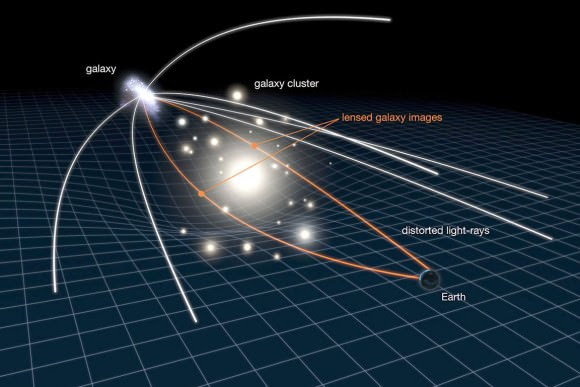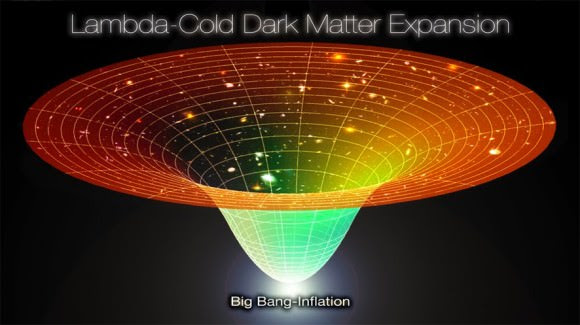Dark Matter has been something of a mystery ever since it was first proposed. In addition to trying to find some direct evidence of its existence, scientists have also spent the past few decades developing theoretical models to explain how it works. In recent years, the popular conception has been that Dark Matter is "cold", and distributed in clumps throughout the Universe, an observation supported by the Planck mission data.
However, a new study produced by an international team of researchers paints a different picture. Using data from the Kilo Degree Survey (KiDS), these researchers studied how the light coming from millions of distant galaxies was affected by the gravitational influence of matter on the largest of scales. What they found was that Dark Matter appears to more smoothly distributed throughout space than previously thought.
For the past five years, the KiDS survey has been using the VLT Survey Telescope (VST) - the largest telescope at the ESO's La Silla Paranal Observatory in Chile - to survey 1500 square degrees of the southern night sky. This volume of space has been monitored in four bands (UV, IR, green and red) using weak gravitational lensing and photometric redshift measurements.

Illustration of how gravitational lensing works, where the gravity of a large galaxy cluster is so strong, it bends, brightens and distorts the light of distant galaxies behind it. Credit: NASA, ESA, L. Calcada
Consistent with Einstein's Theory of General Relativity, gravitational lensing involves studying how the gravitational field of a massive object will bend light. Meanwhile, redshift attempts to gauge the speed at which other galaxies are moving away from ours by measuring the extent to which their light is shifted towards the red end of the spectrum (i.e. its wavelength becomes longer the faster the source is moving away).
Gravitational lensing is especially useful when it comes to determining how the Universe came to be. Our current cosmological model, known as the Lambda Cold Dark Matter (Lambda CDM) model, states that Dark Energy is responsible for the late-time acceleration in the expansion of the Universe, and that Dark Matter is made up of massive particles that are responsible for cosmological structure formation.
Using a slight variation on this technique known as cosmic sheer, the research team studied light from distant galaxies to determine how it is warped by the presence of the largest structures in the Universe (such as superclusters and filaments). As Dr. Hendrik Hildebrandt - an astronomer from the Argelander Institute for Astronomy (AIfA) and the lead author of the paper - told Universe Today via email:

A rare phenomena known as "sprites" being seen above the La Silla Observatory in Chile, Credit: ESO/Petr Horálek
Using this technique, the research team conducted an analysis of 450 square degrees of KiDS data, which corresponds to about 1% of the entire sky. Within this volume of space, the observed how the light coming from about 15 million galaxies interacted with all the matter that lies between them and Earth.
Combining the extremely sharp images obtained by VST with advanced computer software, the team was able to carry out one of the most precise measurements ever made of cosmic shear. Interestingly enough, the results were not consistent with those produced by the ESA's Planck mission, which has been the most comprehensive mapper of the Universe to date.
The Planck mission has provided some wonderfully detailed and accurate information about the Cosmic Microwave Background (CMB). This has helped astronomers to map the early Universe, as well as develop theories of how matter was distributed during this period. As Hildebrandt explained:

The LCDM cosmological model assumes the existence of Dark Matter and Dark Energy, and that both played an active role in the formation of the Universe. Credit: Wikipedia Commons/Alex Mittelmann
However, Hildebrandt and his team found values for these parameters that were significantly lower than those found by Planck. Basically, their cosmic shear results suggest that there is less matter in the Universe and that it is less clustered than what the Planck results predicted. These results are likely to have an impact on cosmological studies and theoretical physics in the coming years.
As it stands, Dark Matter remains undetectable using standard methods. Like black holes, its existence can only be inferred from the observable gravitational effects it has on visible matter. In this case, its presence and fundamental nature are measured by how it has affected the evolution of the Universe over the past 13.8 billion years. But since the results appear to be conflicting, astronomers may now have to reconsider some of their previously held notions.
"There are several options: because we do not understand the dominant ingredients of the Universe (dark matter and dark energy) we can play with the properties of both," said Hildebrandt. "For example, different forms of dark energy (more complex than the simplest possibility, which is Einstein’s “cosmological constant”) could explain our measurements. Another exciting possibility is that this is a sign that the laws of gravity on the scale of the Universe are different from General Relativity. All we can say for now is that something appears to be not quite right!"
|
Friday, December 9, 2016
ESO Survey Shows Dark Matter to be Pretty “Smooth”
Subscribe to:
Post Comments (Atom)
ENERGY NEWS
Oil prices rally on geopolitical tensions April 10 (UPI) -- Geopolitical factors spilled over into the broader economic mood early ...
-
SpaceX Postpones Falcon 9 Rocket Launch Resumption to January 2017 Ken Kremer द्वारा SpaceX Falcon 9 Stage 1 arriving in Califo...
-
© Masao et al. / ELife 2016 MOSCOW, December 14 - RIA Novosti . Scientists have found traces in Tanzania unusually l...
-
06-Apr-2017 Honey Bees Have Sharper Eyesight Than We Thought Research conducted at the University of Adelaide has discovered that be...
-
LMRC Recruitment 2017 lmrcl.com Vacancy Latest Notification Apply ALIMCO Recruitment 2017 alimco.in Various Posts 55 Openings App...
-
Bob King द्वारा Striations exposed on the surface between Martian sand dunes (one pictured at top) in Lucaya Crater indicate fl...

No comments:
Post a Comment